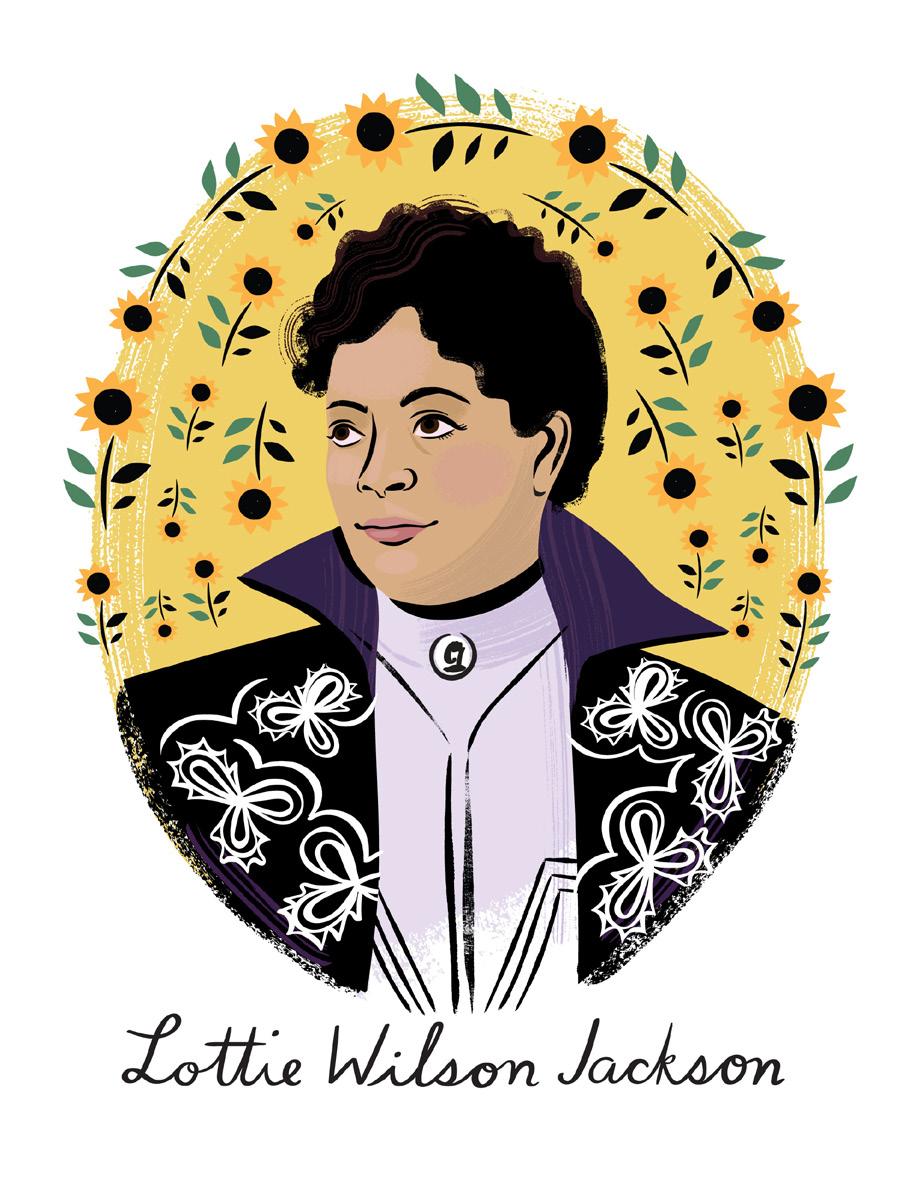
3 minute read
Her Legacy: Lottie Wilson Jackson, Shoulders to Stand On
Shoulders to Stand On
ARTICLE BY: SOPHIA WARD BREWER FOR THE GREATER GRAND RAPIDS WOMEN’S HISTORY COUNCIL
Advertisement
Lottie Wilson Jackson spent her life honoring women models, like 18th-century writer Phyllis Wheatley. Lottie served on the Phyllis Wheatley Home Association Board, travelling to initiate Phyllis Wheatley women’s clubs all over, including in Grand Rapids. As we continue to celebrate the centennial year of the 19th Amendment and as we approach a historic election, let’s add names and faces to the shoulders we stand upon. Let’s remember the countless women who have been fi ghting for women and civil rights since the beginning of time. They were pioneers, suffragists, marchers, politicians, protesters, doctors, lawyers and nurses. They were mothers, daughters, sisters and wives. We honor women like Lottie Wilson Jackson for their perseverance, persistence, resiliency and strength. For theirs are the shoulders we stand on.
As an African American woman thinking about voting, public service and traveling, I stand on the shoulders of national fi gures like Susan B. Anthony and Rosa Parks, but I also stand on the shoulders of Michigan’s Lottie Wilson Jackson. You might never have heard of this suff ragist, artist and activist, but Lottie Wilson Jackson travelled the country promoting her art work and fi ghting for women’s and civil rights until her death in 1914. She also took a famous stand in 1899 in Grand Rapids.
Born in Niles, Michigan as Charlotte Wilson, Lottie was just under 10 years old when on January 1, 1863, President Lincoln issued the Emancipation Proclamation, declaring the freedom of all persons held as slaves in America. She was reared in the North, but imagine the excitement of this young child at the thought of being able to move about this great country in freedom. As an adult, however, Lottie saw her dreams deferred because she was an African American woman.
Lottie Wilson Jackson fully understood the burden she carried as a woman of color. In the late spring of 1899, in fact, she spoke up at the National American Woman Suff rage Association convention in Grand Rapids about the separate coach laws being reintroduced into the South, where NAWSA had begun to travel. She proposed the following resolution, “that colored women ought not to be compelled to ride in smoking cars, and that suitable accommodations should be provided for them.” Th e resolution was tabled by Susan B. Anthony herself, widely known for her portraits of historical subjects
essentially stating that women were still “helpless and disenfranchised” and could do nothing to help women of color with this issue.
Naturally, she was disappointed by the tabled resolution; and before Lottie left Grand Rapids in May of 1899, she spoke at the home of Emma Ford to the Married Ladies Nineteenth-Century Club, the oldest of the local African American women’s clubs. Th en she sought further support from women and people of color by travelling the country and addressing colored audiences about the rights and specifi c treatment of African American women. In August of 1899, Lottie attended the threeyear-old National Association of Colored Women’s convention in Chicago, where she reported on the failed resolution proposed at the national suff rage meeting a few months earlier. Minutes of the Chicago meeting LLUSTRATIONS BY LIBBY VANDERPLOEG

was endorsed and heartily supported by its members including Mary Church Terrell, the national association’s president at the time.
Lottie Wilson Jackson was also a notable artist. Having studied at the Art Institute of Chicago, in 1897 she opened an art studio in Bay City, Michigan, and became record that a resolution regarding the separate coach law
and notable Americans like Crispus Attucks, Frederick Douglass, and his fi rst wife, Anna Murray Douglass. Wilson’s most famous painting was created after her move to Washington, D.C. in 1901, when she used a photograph to repaint the famous portrait of Sojourner Truth with President Abraham Lincoln, after the original had been destroyed by fi re. In 1902, Wilson met President Th eodore Roosevelt when she presented him with a historic memento that the “colored people of Baltimore” had given to Abraham Lincoln at his second inaugural.
GGRWHC’s program year honoring the 19th Amendment centennial was interrupted by the coronavirus outbreak. We regret especially the loss of the August 26th celebration; but continue to follow us on Facebook, read our monthly features in Women’s Lifestyle Magazine, and sign up for our hard copy and electronic newsletters at ggrwhc.org!







